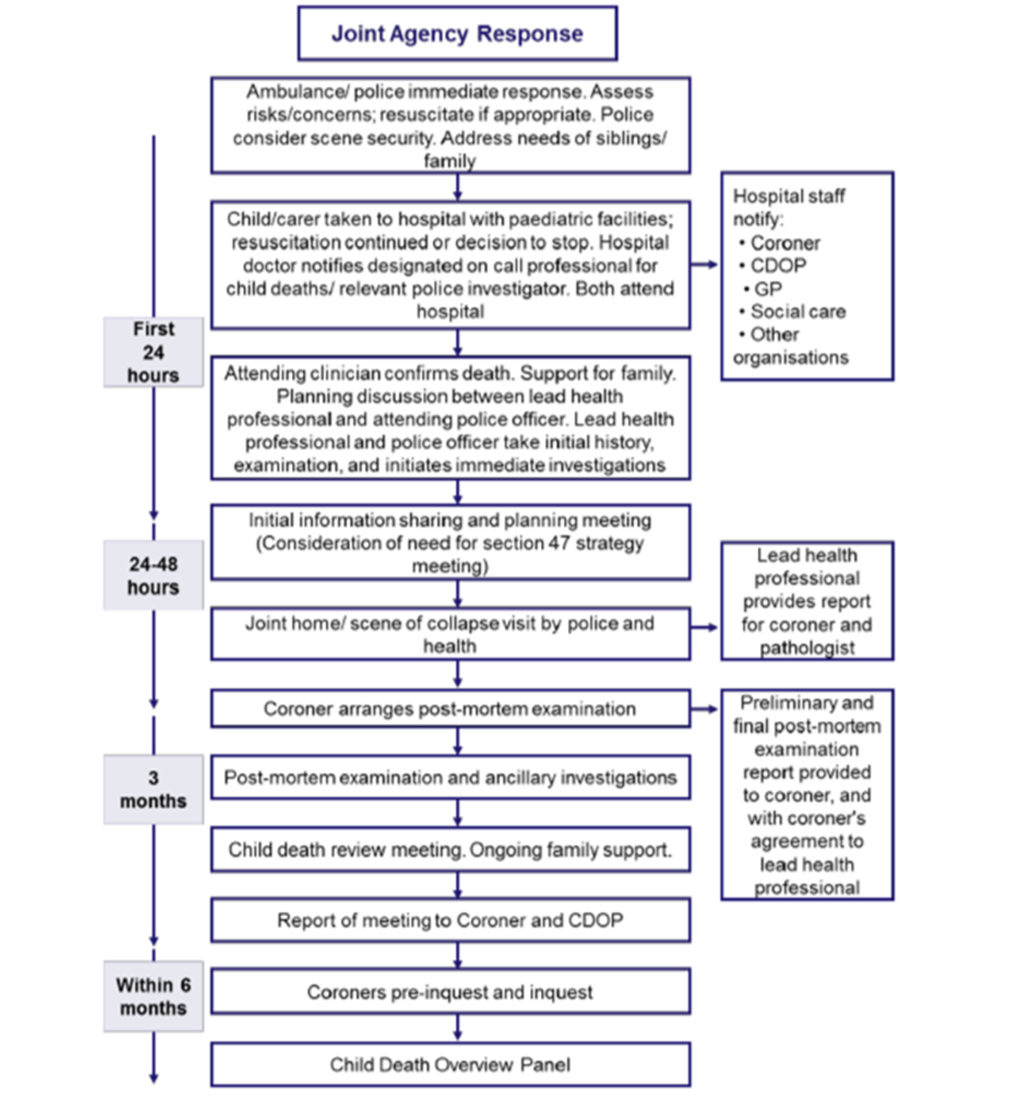
Tees Child Death Overview Panel Procedure
This procedure is intended for anyone involved in the response to an unexpected death of a child.
1. Introduction
1.1 The death of a child is a devastating loss that profoundly affects bereaved parents as well as siblings, grandparents, extended family, friends and professionals who were involved in caring for the child in any capacity. Families experiencing such a tragedy should be met with empathy and compassion. They need clear and sensitive communication. They also need to understand what happened to their child and know that people will learn from what happened. The process of expertly reviewing all children’s deaths is grounded in deep respect for the rights of children and their families, with the intention of preventing future child deaths.
1.2 Since 1 April 2008, there has been a legal requirement that Child Death Overview Panels conduct a review for all child deaths aged 0-17 years who normally reside in their area (excluding stillbirths and legal terminations of pregnancy). The revised Child Death Review: Statutory and Operational Guidance (England) was published in October 2018 for clinical commissioning groups and local authorities as child death review partners. The guidance set out key features of what a good Child Death Review (CDR) process should look like and the statutory requirements that must be followed following the death of a child who is normally resident in England. It builds on the statutory requirements set out in Working Together to Safeguard Children (2018) and clarifies how individual professionals and organisations across all sectors involved in the child death review contribute to reviews. The guidance sets out the process in order to:
- improve the experience of bereaved families, and professionals involved in caring for children
- ensure that information from the child death review process is systematically captured in every case to enable learning to prevent future deaths and, through the National Child Mortality Database, identify learning at a national level, and inform changes in policy and practice.
2. Child Death Overview Panel (CDOP) Process
2.1 The purpose of the Child Death Overview Panel (CDOP) review and/or analysis is to identify any matters relating to the death, or deaths, that are relevant to the welfare of children or to public health and safety, and to consider whether action should be taken in relation to any matters identified.
2.2 The CDOP requests information from persons and/or organisations for the purposes of enabling and assisting the review/analysis process – the person or organisation must comply with these request, and if they do not, the CDOP may take legal action to seek enforcement.
2.3 The functions of the CDOP include:
- to collect and collate information about each child death, seeking relevant information from professionals;
- to analyse the information obtained, including the report from the Child Death Review Meeting (CDRM), in order to confirm or clarify the cause of death, to determine any contributory factors, and to identify learning arising from the child death review process that may prevent future child deaths;
- to make recommendations to all relevant organisations where actions have been identified which may prevent future child deaths or promote the health, safety and well-being of children;
- to notify the Child Safeguarding Practice Review Panel and Local Safeguarding Children Partnership when it suspects that a child may have been abused or neglected;
- to notify the Medical Examiner and the doctor who certified the cause of death, if it identifies any errors or deficiencies in an individual child’s registered cause of death. Any correction to the child’s cause of death would only be made following an application for a formal correction;
- to provide specified data to the National Child Mortality Database (NCMD);
- to produce an annual report for child death review partners on local patterns and trends in child deaths, any lessons learnt and actions taken, and the effectiveness of the wider child death review process; and
- to contribute to local, regional and national initiatives to improve learning from child death reviews, including, where appropriate, approved research carried out within the requirements of data protection.
3. Joint Agency Response
3.1 In order to respond appropriately to each death, senior professionals attending the child at the end of his/her life should consult with each other in order to determine the correct course of action. This is relevant to all child deaths, wherever they occur.
3.2 A coordinated Joint Agency Response should be triggered if a child’s death:
- is or could be due to external causes;
- is sudden and there is no immediately apparent cause (including SUDI/C);
- occurs in custody, or where the child was detained under the Mental Health Act;
- where the initial circumstances raise any suspicions that the death may not have
been natural; or
- in the case of a stillbirth where no healthcare professional was in attendance.
3.3 The response is initiated by completing a Notification of a Child Death via the eCDOP link for notification of a death to CDR partners
3.4 The Reporting Form (previously “Form B”) is used for gathering information from agencies or professionals who have information relevant to the case. Reporting forms should be completed by the relevant responsible officer and shared with the relevant CDOP to inform the Joint Agency Response. For certain child deaths, a supplementary Reporting Form should also be completed as required.

4. When a Child Dies: child death review guide for parents and carers
4.1 A guide for parents, families, and carers to help understand and navigate the child death review process, When a Child Dies. This document should be offered, in a printed format, to all bereaved families and/or carers. Providers should be familiar with its contents in order to ensure that bereaved families and carers are offered the best possible support.
Staff who cared for the child should also be offered appropriate support.